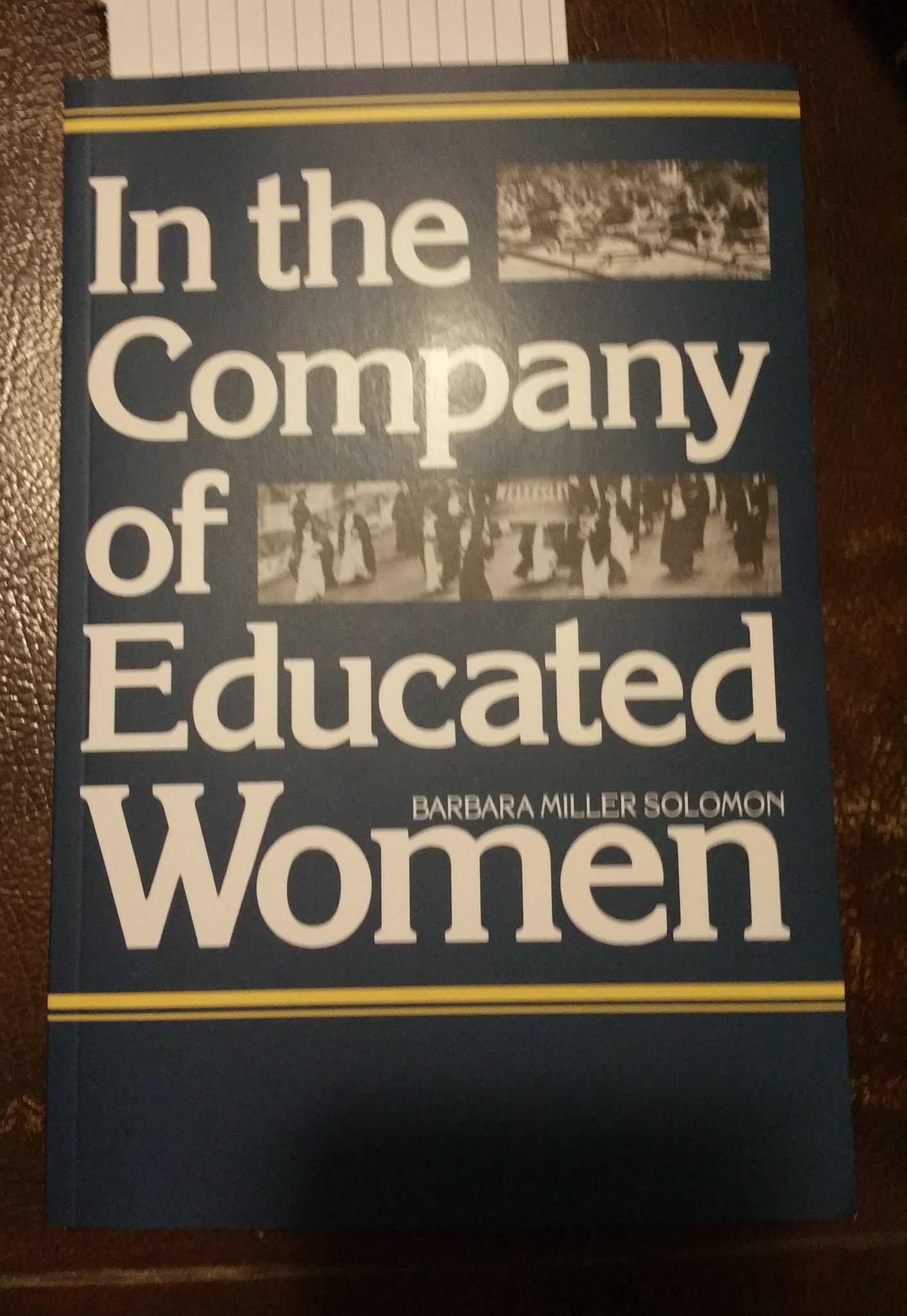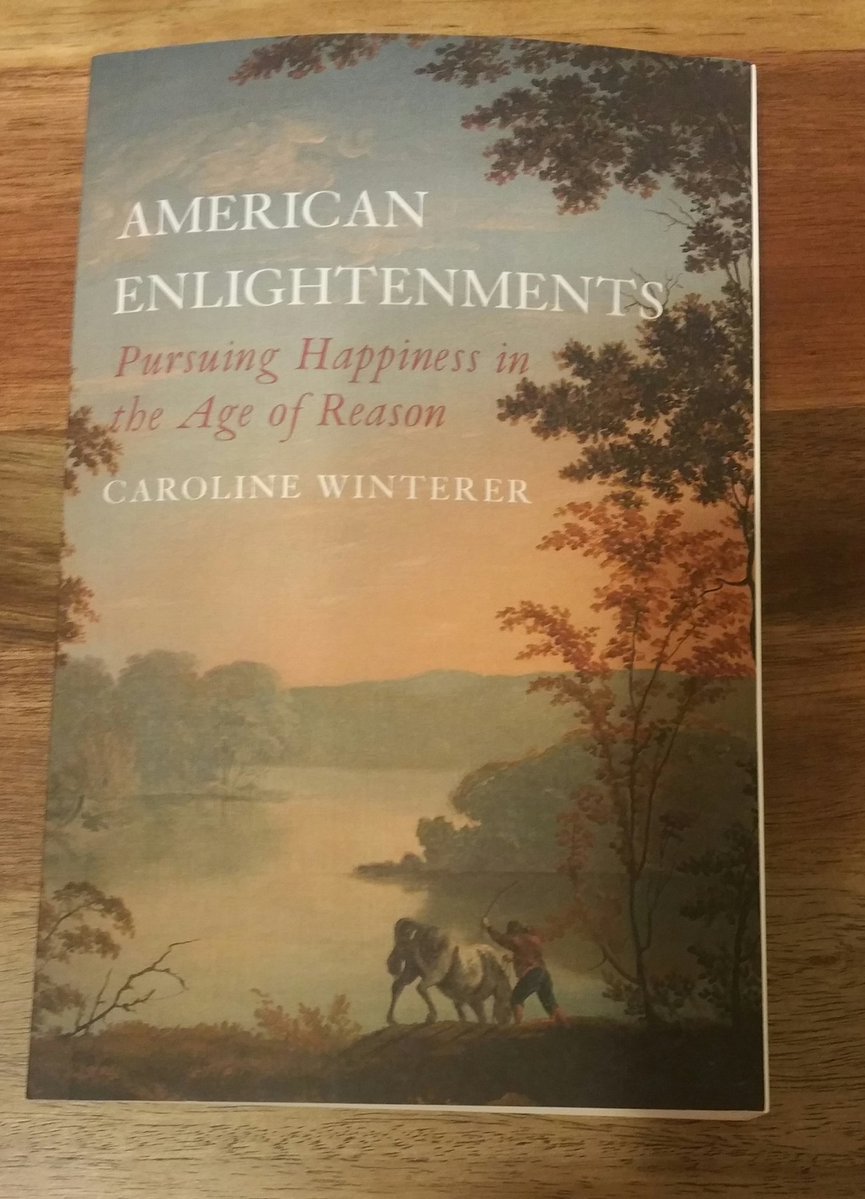This weekend I am reading In the Company of Educated Women by Barbara Miller Solomon. Though published in 1985, Solomon’s volume remains the standard survey of the history of (mostly white) women’s higher education in the United States. It is briskly written and pleasant to read, and its narrative is comfortingly familiar to anyone who has taught the survey using a recent edition of any multi-authored textbook, because textbook sections that deal with women’s lives and aspirations clearly draw from this important work.
 Solomon rings the changes from Republican motherhood to the moral reformer to the middle-class daughter to the modern co-ed. This is the centuries-long story of how women in America made their way into the college classroom and became the majority of collegians (though not the majority of tenured or tenure-track professors). Solomon gestures toward Black women’s higher education at various points, but her focus is on the white middle-class woman and on those women who aspired to join that class. It’s not a perfect book, but it’s a very useful book.
Solomon rings the changes from Republican motherhood to the moral reformer to the middle-class daughter to the modern co-ed. This is the centuries-long story of how women in America made their way into the college classroom and became the majority of collegians (though not the majority of tenured or tenure-track professors). Solomon gestures toward Black women’s higher education at various points, but her focus is on the white middle-class woman and on those women who aspired to join that class. It’s not a perfect book, but it’s a very useful book.
While reading along, I noticed something – the absence of certain verbs, the verbs I am accustomed to encountering when I read recent scholarship about women’s lives, women’s thought, women’s intellectual work. They are the transitive verbs of women’s physical labor, but verbs applied as well to women’s intellectual work: “fashioned,” “crafted,” “shaped,” “weaved,” “embroidered,” “birthed,” “nurtured,” etc.
I am accustomed to encountering these verbs in the work of social historians, but I find them in the work of intellectual historians as well when they are writing about women. Women “nurture” networks of communication, they “fashion” narratives, they “birth” intellectual communities, they “weave” arguments.
I always find these verbs jarring – though often in a good way. They are a reminder that women’s lives were (!) relegated to the realm of materiality; to men alone belonged significant ideation. So relegated, women nevertheless found ways to think and to pass that thinking down by means other than those available to people (men) whose work entailed thinking and writing for a living. This is the intended import of such verbs, and this is one reason among many why I would not expect to find them in a history of women in higher education written in 1985.
But just as often I find these verbs jarring for their condescension – or, I guess, their submission to the status quo.
“Fashioned,” “crafted,” shaped,” “weaved,” “embroidered,” “birthed,” “nurtured” – in historiography, these are the action verbs of the subaltern. This is how historians carve out (!) agency for those who, at first glance, seem to have none: by describing the realm of will and intent and ideation in physical terms.
The ur-text for this materialist style is, I think, Eugene Genovese’s Roll, Jordan, Roll: The World the Slaves Made. Genovese contended for the agency of the enslaved, but he presented that agency in mostly material, physical terms – within the grievous psychic constraints and physical sufferings of slavery, will did its work by hand, both literally and figuratively.
Take Eugene Genovese, combine him with Clifford Geertz, add some strains of feminist theory – Annette Kolodny, Carol Gilligan, Julia Kristeva – and I think you have the makings of a style of writing that manages to signal both the historical limitations women faced and their acts of will to overcome them. My surmise is that, as is the case with so many other kinds of thought, the historiography using these verbs after Genovese (maybe before him?) appeared first in Black studies and African American history and then was ported over into women’s history.
But this stylistic emphasis on the physicality of women’s lives can have the unfortunate effect of reinscribing a traditional division between women and men as historical subjects, as thinkers. In this style, women do their intellection metaphorically, concretely, while men do their intellection purely, abstractly – and we all know which kind of thinking is the “better” kind.
Or do we?
 One promising route out of what I see as a historiographic cul de sac is not to set aside the metaphors of physical (and gendered) labor when discussing the history of ideas. Rather, it is to deploy those metaphors more widely, more inclusively.
One promising route out of what I see as a historiographic cul de sac is not to set aside the metaphors of physical (and gendered) labor when discussing the history of ideas. Rather, it is to deploy those metaphors more widely, more inclusively.
Caroline Winterer does this in her fascinating work, American Enlightenments: Pursuing Happiness in the Age of Reason. Darwin, she writes, sought to “craft a new story about the development of life on earth,” and eventually “Americans and Europeans together…crafted a new story of their earth” (42, 44). John Adams felt that America was bereft of the kinds of institutions “that had nurtured European political and intellectual life since the Renaissance” (15), while Adams himself “nurtured a pet theory that since antiquity priests and other fanatics had been burning all the books that would undermine the doctrines of their despotic religious regimes” (191). John Adams as nursemaid to an idea – that is one way to remember the ladies!
The verbs of culture and care, the verbs of domesticity, the verbs of manual labor – these verbs, when reserved for the subaltern, the marginalized, the overlooked, the underrepresented or unrepresented agents in the historical record, sometimes grant those subjects either social agency at the cost of limiting their intellectual significance, or intellectual agency at the cost of limiting their social significance.
But in a discipline that (rightly) privileges the ideal over the material, but in which some insist that ideas ultimately can and must be extracted from their context and studied in the abstract in order to be properly understood, it is a salutary practice to deploy verbs that gesture toward the fact that all thinkers, women and men alike, are embodied beings, and all ideas have their origins and ends in the grit and dirt and homely fact of embodied human life.
“We are the words; we are the music; we are the thing itself.” – Virginia Woolf

4 Thoughts on this Post
S-USIH Comment Policy
We ask that those who participate in the discussions generated in the Comments section do so with the same decorum as they would in any other academic setting or context. Since the USIH bloggers write under our real names, we would prefer that our commenters also identify themselves by their real name. As our primary goal is to stimulate and engage in fruitful and productive discussion, ad hominem attacks (personal or professional), unnecessary insults, and/or mean-spiritedness have no place in the USIH Blog’s Comments section. Therefore, we reserve the right to remove any comments that contain any of the above and/or are not intended to further the discussion of the topic of the post. We welcome suggestions for corrections to any of our posts. As the official blog of the Society of US Intellectual History, we hope to foster a diverse community of scholars and readers who engage with one another in discussions of US intellectual history, broadly understood.
Great post! There’s a good bio of Barbara Miller Solomon at the Jewish Women’s Archive.
https://jwa.org/encyclopedia/article/Solomon-Barbara-Miller
Great post!
I’m also bit surprised. Has intellectual history generally proceeded as if men do their intellection purely abstractly?
I’m asking because historians of science don’t and haven’t for some time treated intellection by scientists as pure abstraction. In other words, the verbs you highlighted don’t strike me as necessarily used to talk about only the subaltern in the writing of historians of science. Perhaps this is because historians of science have been pretty interested in doing something like the embodied social history of intellectual as a primary if not the project for some time now.
For instance on embodiment there’s this classic: Christopher Lawrence and Steven Shapin, eds., Science Incarnate: Historical embodiments of Natural Knowledge (University of Chicago Press, 1998
There’s also literature on (often elite male) mathematicians and natural scientists as crafting fashioning arguments, experiments, proofs, and theories, or self-fashioning, and scientific journals or laboratories as nurturing fields of inquiry.
This is due, in part to much of of the production of works history of science doing for the past 30-40 years what (again) Steven Shapin calls lowering the tone: studying science’s history as if the people who did it have bodies. http://science.sciencemag.org/content/330/6003/450.
Shapin is far, far from the only historian of science to do this. Many, many others demonstrate the importance of craft and embodied knowledge to the emergence and practice of modern science. Here is a recent example from Pamela Smith who has been working on bodes and craft for some time: https://www.makingandknowing.org/?page_id=213
By now the concepts of crafting, shaping, fashioning, and nurturing ideas, people, and community is sufficiently embedded in the literature on the history of science that I borrowed from the pretty standard writing conventions of the field to use all of these words in my book to characterize the activities and ideas of mid-20th century elite intellectuals.
This focus on embodiment and craft is partially a product of the ways that history of science has been interested in the early modern period (read “Scientific Revolution”), and partially to way that the field is always asking about the boundary problem: who has counted as a “scientist” and who has not. This is why part of my and the broader historiography on science’s history has examined how very idea that the scientist’s intellect is disembodied is and has been a political / ideological production rooted in a fiction that ideas live outside of interpretive communities and that minds occur outside of bodies.
From this perspective, another question is how has it been that certain people and their ideas but not others (as L.D. notes) have been recipients of this particular fiction? Also, given this history of who has and who has not been the beneficiary of the fiction of disembodied ideas, does writing the history of disembodied ideas perpetuate some of the systems of social inequality that initially produced these fictions?
“a fiction that ideas live outside of interpretive communities and that minds occur outside of bodies”
I think it would be a gross oversimplification and something of an injustice for me to say that this fiction is accepted as axiomatic for intellectual history. But the field is riven by some productive tensions, and one of them is the tension between those who see or draw a sharp distinction between ideas and their social/cultural context and those who treat ideas as immanent. There are intellectual historians who believe it is our business to look at ideas “in themselves” — as if such a thing could ever exist or has ever existed.
There’s also Greenblatt’s ‘Renaissance Self-Fashioning’, though whether it’s relevant to this discussion I’ll let others say.